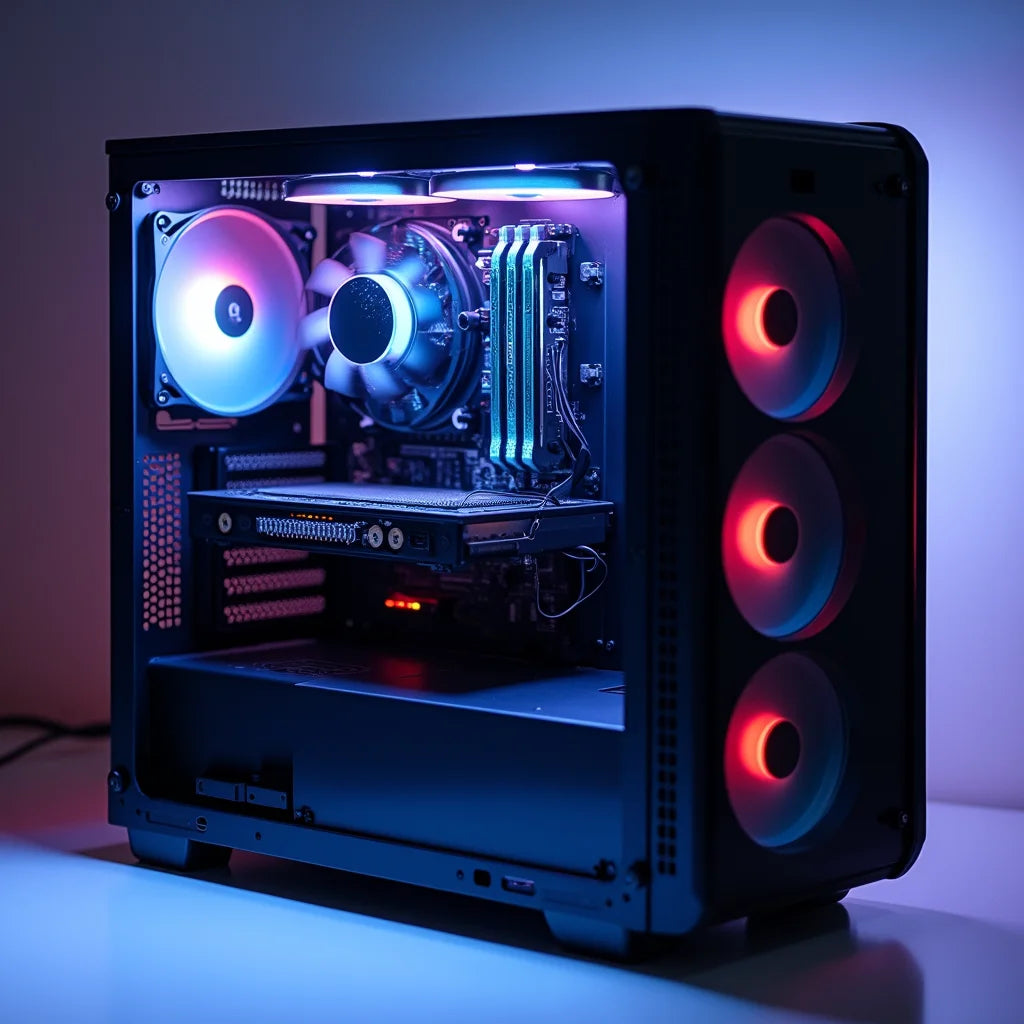
Choosing PC Building Kits for Performance and Value
Nova Electronics Nova ElectronicsShare
Updated on: 2025-09-13
Table of contents for PC building kits
- PC building kits overview and benefits
- Essential tips for PC building kits success
-
Step-by-step process to assemble PC building kits
- Step 1: Plan and verify compatibility
- Step 2: Prepare a clean workspace
- Step 3: Install CPU and memory
- Step 4: Mount M.2 storage and confirm lanes
- Step 5: Seat the motherboard and connect front I/O
- Step 6: Fit the power supply and route cables
- Step 7: Install the GPU and any 2.5/3.5-inch drives
- Step 8: First boot, firmware updates, and OS install
- Summary and key takeaways on PC building kits
- PC building kits frequently asked questions
- About the author
PC building kits deliver a curated, compatibility-tested path to assemble your desktop without the uncertainty of mismatched parts. Whether you are evaluating PC assembly kits, DIY PC kits, or barebones PC kits, the goal is the same: reduce guesswork and build a stable, upgrade-ready machine. This guide explains how to choose between custom gaming PC kits and productivity-focused bundles, what to expect inside different configurations, and how to follow a precise process from unboxing to first POST. If you are new to this space, explore a selection of PC building kits to learn how each bundle aligns with your performance, noise, and budget goals.
Essential tips for PC building kits success
- Define your primary use case first. Frame rates, creative workloads, or office tasks will dictate the CPU, GPU, cooling, and memory profile you need.
- Choose kits with clear part lists and documented compatibility. Look for matched CPU socket, memory standard, case clearance, and power limits.
- Favor power supplies with headroom. A quality 80 Plus unit sized for peak draw plus future upgrades improves stability and longevity.
- Prioritize airflow and thermals. Cases with front mesh, defined intake and exhaust paths, and PWM fan control reduce noise and extend component life.
- Match memory kits to platform guidelines. Confirm DDR speed, timings, and module count on the motherboard qualified vendor list (QVL) where available.
- Use an anti-static strap and a non-conductive surface. Handle PCBs by the edges and keep small parts organized in labeled containers.
- Update motherboard firmware early. Newer BIOS builds often improve memory compatibility, boost behaviors, and stability across DIY PC kits.
- Test outside the case if issues arise. A minimal “bench” build with CPU, one memory stick, and GPU simplifies troubleshooting.
- Document cable routes. Clean management improves airflow and serviceability; it also reduces strain on headers and connectors.
- Keep receipts and serials. Good documentation helps with returns, warranty claims, and future resales of components.
Step-by-step process to assemble PC building kits
Step 1: Plan and verify compatibility
Identify your platform and confirm CPU socket, chipset, and memory standard. If you are mixing components beyond the kit, ensure the case supports your motherboard form factor and cooler height, and that the power supply has the right PCIe and EPS connectors. For gaming builds, verify GPU length and width with the case’s specs and check whether a vertical mount is supported without choking airflow. If your kit includes a Wi-Fi board, confirm antenna passthroughs and placement for optimal reception.
Step 2: Prepare a clean workspace
Work on a flat, well-lit, non-conductive surface. Use an anti-static strap on your wrist clipped to an unpainted metal part of the case. Keep thermal paste, isopropyl alcohol, and microfiber cloths within reach. Lay out the screws by type (motherboard, drive, PSU, fan) in separate trays. Read the quick-start guides for your case and motherboard before starting; small details such as standoff positions or front-panel pin layouts save time later.
Step 3: Install CPU and memory
Open the socket lever, align the CPU by the marked triangle, and lower it gently into place without sliding. Lock the retention mechanism evenly. Apply the cooler per the manufacturer’s instructions, tightening diagonally to even pressure. Seat memory modules in the recommended slots (often A2/B2) until latches click. Confirm that the memory speed you plan to enable via XMP or EXPO is within the board’s supported range for your module count.
Step 4: Mount M.2 storage and confirm lanes
Remove the M.2 heatsink, insert the NVMe drive at an angle, and secure it with the standoff screw. Reinstall the heatsink with the thermal pad aligned. Check the manual for which M.2 slots connect to CPU lanes versus chipset lanes. For high-performance workloads, place your primary drive in the slot with the best bandwidth and cooling. If your kit includes multiple drives, label them to simplify OS installation and data migration later.
Step 5: Seat the motherboard and connect front I/O
Install the I/O shield if required and confirm case standoffs align with the board’s holes. Lower the motherboard carefully and secure it with the correct screws, avoiding overtightening. Route front-panel connectors (power switch, reset, HDD LED), front USB, and audio headers cleanly to reduce strain. Use the manual to match the front-panel pins; incorrect polarity on LEDs is a common oversight and easy to correct.
Step 6: Fit the power supply and route cables
Install the power supply with the fan oriented toward ventilation. Pre-route the 24-pin ATX, EPS CPU power, and PCIe cables behind the motherboard tray before closing tight spaces with the GPU installed. If the kit includes cable extensions or combs, use them to maintain gentle bends and proper slack. Avoid mixing modular cables between brands to prevent pinout mismatches. Tidy excess cable length in the PSU shroud.
Step 7: Install the GPU and any 2.5/3.5-inch drives
Remove the correct expansion slot covers and press the GPU into the top PCIe slot until the latch clicks. Support the card while securing it with case screws to prevent sag. Connect the PCIe power leads firmly; daisy-chaining on high-draw GPUs is discouraged in favor of independent cables where possible. Mount 2.5-inch SSDs and 3.5-inch HDDs in their trays with vibration damping. Connect SATA power and data cables with gentle routing and strain relief.
Step 8: First boot, firmware updates, and OS install
Connect a display and keyboard, then power on. If there is no video, reseat memory, verify EPS/ATX power, and check the GPU. Enter firmware, monitor temperatures, enable XMP or EXPO, and set the correct boot device. Update to the latest stable BIOS for improved compatibility. Install the operating system on the intended NVMe drive and then the platform drivers. If problems persist, contact support with your build list, firmware version, and error behavior for fast diagnostics.
Summary and key takeaways on PC building kits
PC building kits consolidate the most important choices in a desktop build and reduce risk by matching components for power, thermals, and form factor. Compared with buying piecemeal parts for DIY PC kits, you save time on compatibility checks and receive a coherent path from unboxing to first boot. Barebones PC kits provide a flexible middle ground for experienced builders who already own storage or a GPU. Custom gaming PC kits place extra emphasis on airflow, power delivery, and memory speed for stable frame rates. If you prefer additional guidance beyond this article, visit our learn hub for more platform-specific build advice, or browse PC components to tailor performance further. Availability, specifications, and prices vary by configuration.
PC building kits frequently asked questions
What is included in a PC building kit?
Offerings vary, but most PC building kits include a case, power supply, motherboard, and CPU cooler. Some packages add a processor, memory, and storage, while others are closer to barebones PC kits that let you reuse or select a GPU and drives. Premium bundles sometimes include pre-routed case fans and thermal accessories. Always check the full bill of materials and confirm whether thermal paste, Wi-Fi antennas, SATA cables, or additional case fans are included. If you need a complete bundle that addresses everything, look for kits that specify a CPU, RAM, and NVMe drive along with verified firmware and cable sets.
Are PC building kits worth it for beginners?
Yes, they are often the best entry point. Kits simplify procurement, reduce compatibility pitfalls, and provide a clear assembly path. The best PC building kits for beginners balance value and upgradability, with sensible choices for power supplies, cooling, and airflow that reduce noise and heat. Beginners benefit from matched memory kits and case layouts that make cable routing straightforward. While experienced builders enjoy full control with DIY PC kits, new builders frequently achieve faster, more reliable results by starting with curated bundles that document recommended firmware and clear installation steps.
Can I find affordable PC building kits under $500?
Yes, but expectations must align with the budget. Affordable PC building kits under $500 are typically oriented toward light productivity, office tasks, or entry gaming with integrated graphics. These bundles often include a motherboard, case, power supply, and sometimes a low-power CPU or cooling solution. Storage and memory may be modest and upgradable later. For gaming with a dedicated GPU, total build cost will exceed this range, but starting with a reliable base kit remains a practical strategy. If you are targeting value, review entry options in PC building kits, then extend with additional components as needs grow.
About the author: Nova Electronics Nova Electronics
Nova Electronics Nova Electronics specializes in component selection, system design, and practical guidance for first-time and experienced builders. This article reflects hands-on expertise with PC building kits, DIY PC kits, and performance tuning for gaming and creative workloads. Thank you for reading, and enjoy your next build.
